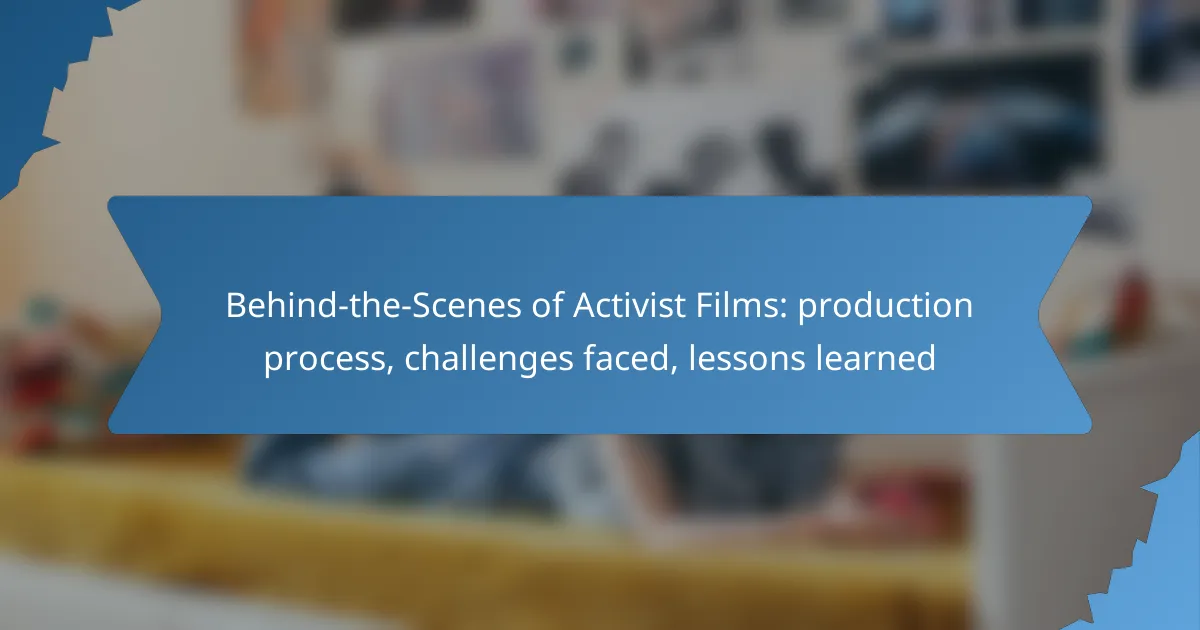Behind the scenes of activist films lies a complex production process that encompasses pre-production planning, filming techniques, post-production editing, and distribution strategies. Filmmakers often face significant challenges, such as securing funding and navigating legal obstacles, which can impact their ability to effectively convey their message. Despite these hurdles, activist films are vital in raising awareness and influencing public opinion, ultimately driving social change.

What are the key stages in the production of activist films?
The production of activist films typically involves four key stages: pre-production planning, filming techniques, post-production editing, and distribution strategies. Each stage is crucial for effectively conveying the film’s message and ensuring it reaches the intended audience.
Pre-production planning
Pre-production planning is essential for laying the groundwork of an activist film. This stage includes defining the film’s objectives, researching the subject matter, and assembling a dedicated team. A well-structured plan can help avoid common pitfalls such as budget overruns and scheduling conflicts.
During this phase, filmmakers should create a detailed budget, which may range from a few thousand to several hundred thousand dollars depending on the scope of the project. Securing funding through grants, crowdfunding, or sponsorships is often necessary to support the production.
Filming techniques
Filming techniques in activist films can vary widely, but they often emphasize authenticity and emotional impact. Documentaries may use observational styles, while narrative films might employ dramatization to engage viewers. Choosing the right technique is crucial for effectively communicating the film’s message.
Filmmakers should consider using handheld cameras for a more intimate feel or drones for sweeping aerial shots, depending on the story being told. It’s important to balance artistic choices with the logistical challenges of filming in various locations, which may require permits and adherence to local regulations.
Post-production editing
Post-production editing is where the film comes together, shaping the narrative and refining the message. This stage involves cutting footage, adding sound, and incorporating visual effects as needed. Effective editing can significantly enhance the emotional resonance of the film.
Filmmakers should be prepared for multiple rounds of revisions, as feedback from test screenings can lead to substantial changes. Utilizing editing software that fits the budget and skill level of the team is essential, with options ranging from free tools to professional-grade software.
Distribution strategies
Distribution strategies are vital for ensuring that the activist film reaches its target audience. Filmmakers can choose from various platforms, including film festivals, streaming services, and social media. Each option has its advantages and can influence the film’s visibility and impact.
It’s important to develop a marketing plan that highlights the film’s themes and engages potential viewers. Collaborating with organizations aligned with the film’s message can also enhance outreach efforts and facilitate screenings in community spaces or educational institutions.

What challenges do filmmakers face in activist films?
Filmmakers in the activist genre encounter numerous challenges that can hinder their production process. Key issues include securing funding, gaining access to subjects, and navigating legal obstacles, all of which can significantly impact the final product.
Funding limitations
Funding is often a critical challenge for activist filmmakers, as many projects rely on grants, donations, or crowdfunding. Traditional funding sources may be hesitant to support films that tackle controversial or sensitive topics, which can limit financial resources.
To overcome funding limitations, filmmakers can explore diverse funding avenues such as partnerships with NGOs, community fundraising events, or online crowdfunding platforms. Establishing a clear budget and demonstrating the film’s potential impact can also attract potential investors.
Access to subjects
Gaining access to subjects, particularly those involved in sensitive issues, can be challenging for filmmakers. Subjects may fear repercussions or may not be willing to share their stories due to privacy concerns or trauma.
Building trust is essential for gaining access. Filmmakers should approach subjects with empathy, clearly communicate the project’s goals, and ensure that participants understand how their stories will be portrayed. Offering anonymity or control over the final cut can also encourage participation.
Legal hurdles
Legal challenges can arise in activist filmmaking, especially when dealing with sensitive content or controversial figures. Issues such as defamation, copyright infringement, and privacy rights must be carefully navigated to avoid legal repercussions.
To mitigate legal risks, filmmakers should consult with legal experts familiar with media law. Obtaining necessary permissions, using releases for interviews, and being transparent about the film’s intent can help protect against potential lawsuits. Understanding local laws regarding filming in public spaces is also crucial.

How do activist films impact social movements?
Activist films play a crucial role in shaping and advancing social movements by raising awareness and influencing public opinion. These films can educate audiences, inspire action, and mobilize communities around specific causes.
Raising awareness
Activist films serve as powerful tools to raise awareness about social issues that may be overlooked or misunderstood. By presenting compelling narratives and visuals, these films can highlight injustices, environmental concerns, or human rights violations, making complex topics accessible to a broader audience.
For example, documentaries about climate change often showcase the impacts on vulnerable communities, prompting viewers to consider their own environmental footprint. This increased awareness can lead to greater public discourse and engagement on critical issues.
Influencing public opinion
Through storytelling and emotional engagement, activist films can significantly influence public opinion on various social issues. By presenting personal stories and expert insights, these films can shift perceptions and encourage viewers to empathize with marginalized groups.
For instance, films addressing racial inequality can challenge stereotypes and promote understanding, ultimately fostering a more informed and compassionate society. Engaging with these films can empower audiences to advocate for change and support relevant policies.

What lessons have filmmakers learned from creating activist films?
Filmmakers have learned that creating activist films requires a deep understanding of the issues at hand and the communities involved. Key lessons include the significance of effective storytelling and the necessity of engaging with the communities that the films aim to represent.
Importance of storytelling
Storytelling is crucial in activist films as it transforms complex issues into relatable narratives. A compelling story can evoke emotions, inspire action, and foster understanding among viewers. Filmmakers should focus on character-driven narratives that highlight personal experiences to create a more profound impact.
Using techniques such as conflict, resolution, and character development can enhance the storytelling process. For example, showcasing a local activist’s journey can humanize the issue and draw in audiences who may not be familiar with the topic. This approach often leads to greater viewer engagement and retention.
Engagement with communities
Engaging with communities is essential for authentic representation in activist films. Filmmakers should prioritize collaboration with local voices to ensure that the narratives reflect the true experiences and perspectives of those affected by the issues. This engagement fosters trust and can lead to more accurate storytelling.
Filmmakers can conduct workshops, interviews, and focus groups to gather insights and feedback from community members. This process not only enriches the film’s content but also empowers the community by involving them in the filmmaking journey. Avoiding a top-down approach is critical; instead, filmmakers should aim for a partnership that respects and uplifts local narratives.

How do activist films differ from traditional documentaries?
Activist films focus on promoting social change and advocacy, while traditional documentaries often aim to inform or entertain without a specific agenda. This distinction shapes their production processes, storytelling techniques, and audience engagement strategies.
Focus on advocacy
Activist films are designed to raise awareness about specific issues and inspire action. Filmmakers often collaborate with grassroots organizations to ensure their narratives align with the advocacy goals of the movements they represent. This partnership can influence the film’s tone, content, and distribution methods.
When producing an activist film, it’s crucial to identify clear objectives and target audiences. Filmmakers should consider how their message can resonate with viewers and what actions they hope to inspire. For example, a film addressing climate change might encourage viewers to adopt sustainable practices or support environmental policies.
Emotional engagement
Emotional engagement is a key element in activist films, as they aim to connect with audiences on a personal level. By using storytelling techniques that evoke empathy, filmmakers can motivate viewers to care about the issues presented. This often involves focusing on individual stories or experiences that highlight broader social problems.
To enhance emotional impact, filmmakers should consider using compelling visuals, personal testimonies, and relatable narratives. For instance, showcasing the struggles of a community affected by pollution can create a powerful emotional response that drives viewers to take action. Balancing facts with emotional storytelling can lead to a more effective advocacy piece.

What are the emerging trends in activist filmmaking?
Emerging trends in activist filmmaking include the use of digital platforms for distribution, collaborative storytelling, and a focus on intersectionality. Filmmakers are increasingly leveraging social media and streaming services to reach wider audiences and engage communities in new ways.
Increased Use of Digital Platforms
Activist filmmakers are turning to digital platforms to distribute their work, allowing for greater accessibility and audience engagement. Streaming services like Netflix and YouTube provide a global reach, enabling filmmakers to share their messages without the constraints of traditional cinema.
Social media plays a crucial role in promoting these films, with platforms like Instagram and TikTok allowing for short clips and trailers that can go viral. This trend encourages filmmakers to create content that resonates quickly and powerfully with viewers.
Collaborative Storytelling
Collaboration is becoming a key element in activist filmmaking, with filmmakers partnering with communities to tell their stories authentically. This approach not only empowers marginalized voices but also fosters a sense of ownership among participants.
Workshops and community screenings are common practices, allowing filmmakers to gather feedback and refine their narratives. Engaging local activists and experts can enhance the film’s credibility and impact.
Focus on Intersectionality
Activist films are increasingly addressing intersectionality, recognizing that social issues are interconnected and affect individuals differently based on their identities. This trend encourages a more nuanced exploration of topics such as race, gender, and class.
Filmmakers are challenged to represent diverse perspectives and experiences, which can lead to richer narratives. By highlighting these intersections, activist films can foster greater empathy and understanding among audiences.
